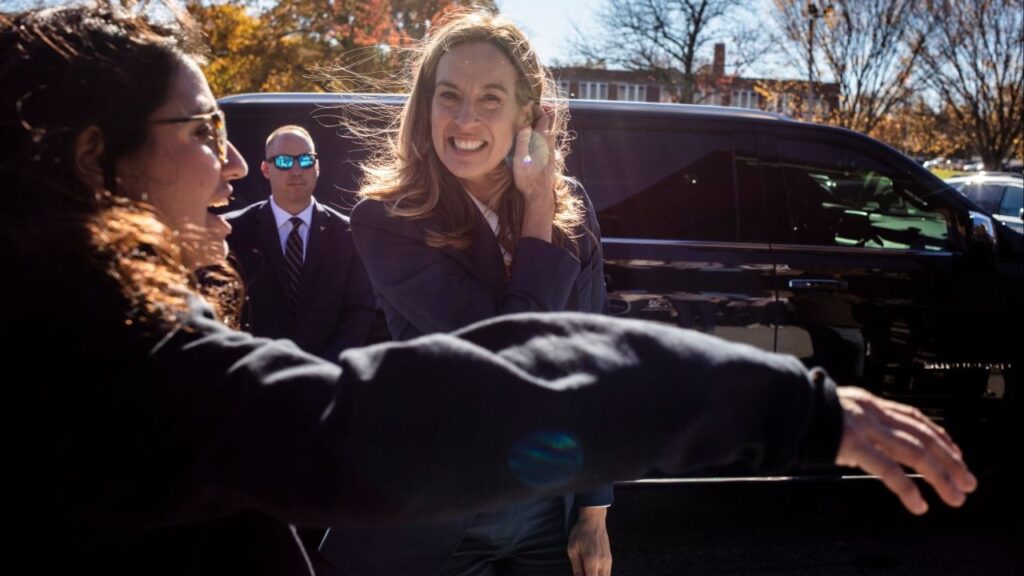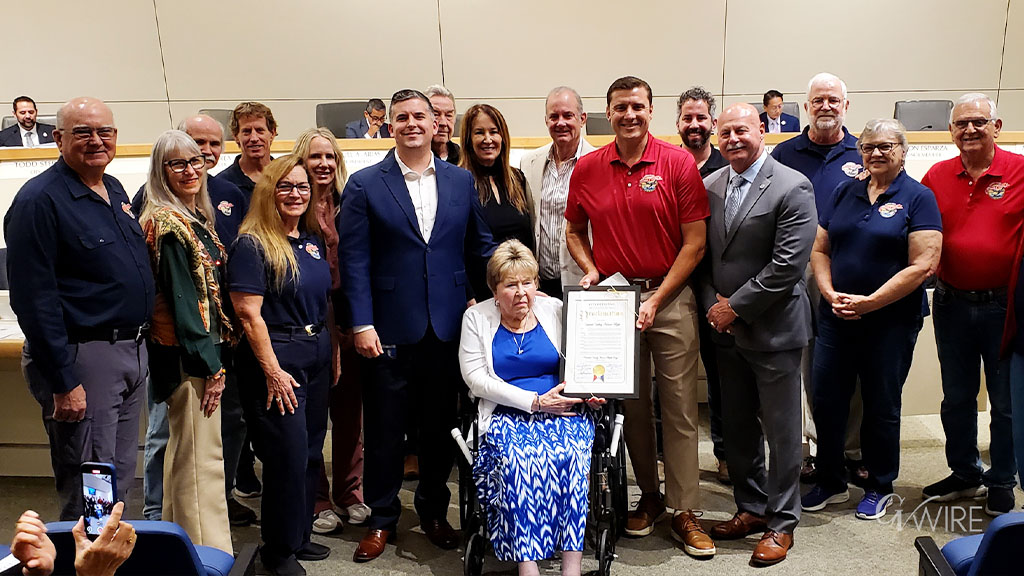Share
|
Getting your Trinity Audio player ready...
|
It’s Thursday evening. You pack up your things at work and hit the road. Maybe you’re thinking about a lunch plan you’ve got with a friend or a show you plan to binge. But you’re not thinking about clocking in tomorrow: You’ve got a three-day weekend.

Grace Gedye
CalMatters
All your weekends, in fact, are three-day weekends.
It’s a utopian vision for some. The standard work week in the U.S. has been stuck at 40 hours for almost a century, even as workers have become dramatically more productive. Evidence from pilot programs suggests that shifting to 32-hour weeks without reducing pay is better for workers and doesn’t hurt revenues. Companies that try it largely stick with it.
But opponents of the idea say most businesses would incur increased costs they couldn’t bear as a result.
California lawmakers have considered — however briefly — legislation that would allow workers to propose alternate 40-hour weeks, such as four, 10-hour days, more than a dozen times since 2005. While business groups oppose the idea of paying workers the same rate for eight fewer working hours per week, they do support giving individual workers the option to propose alternate 40-hour schedules. Labor groups, however, oppose that idea.
Here’s what you need to know about the debate and why most Californians are unlikely to get a four-day work week in the near future.
Is a Four-Day Work Week up for Grabs?
The 40-hour week wasn’t pre-ordained. Economist John Maynard Keynes famously predicted in 1930 that productivity and living standards over the next century would rise so much that, by 2030, we would only have to work for 15 hours per week. In 1956, then-Vice President Richard Nixon predicted a four-day work week in the “not too distant future.”
Neither prediction came true. Keynes was right that productivity would increase, but wrong about the consequences for workers. That may finally be changing. In recent years, advocates and researchers have been building a case for the viability of a shorter work week.
In Iceland, for example, trials in 2015 and 2017 shifted workers to 35- or 36-hour weeks without a reduction in pay. The tests spanned government agencies, schools, police stations, hospital departments and more, affecting more than 2,500 workers. Worker well-being and work-life balance improved while productivity was maintained or increased across the majority of workplaces, according to a report from Autonomy, a progressive think tank that consults with companies looking to shift to a four-day work week.
A more recent trial in the United Kingdom found similar results. In 2022, more than five dozen companies in industries from marketing to manufacturing reduced work hours in one of several ways — a coordinated extra day off, or staggered days off, or an annualized 32-hour week for companies with seasonal demands — while maintaining pay. The report, authored by Autonomy and including analysis from researchers at the University of Cambridge and Boston College, found that workers’ stress decreased on average, and most workers found it easier to balance work and caregiving commitments.
There were benefits for businesses, too: The rate of workers quitting decreased during the trial, and revenue remained essentially steady, increasing by 1.4% on average. By the end of the seven- month trial, 92% of the companies said they would continue the policy, and 18% decided it would be a permanent change.
The rate of workers quitting decreased during the trial, and revenue remained essentially steady, increasing by 1.4% on average.
When the San Francisco-based social media management company Buffer decided to try a four- day week in May 2020, amid COVID-19 lockdowns, Julia Cummings remembers feeling excited and relieved. Cummings, a senior customer advocate with the company, was living in New York at the time. The extra day gave her time to run errands when grocery stores were less crowded, she said. “We’re humans, and we have all of these actual duties outside of work,” she said. Having the “space to do that just felt really like, ‘Phew! Okay cool, this is great.’”
When the trial started, Buffer’s CEO wrote that the aim was to improve employees’ well-being. “This isn’t about us trying to get the same productivity in fewer days,” he wrote in a company blog post. But after internal surveys and data showed sustained productivity, the company decided in 2021 to stick with the change.
For Cummings, who now lives in Los Angeles, the shift to a four-day week meant experimenting with staggered days off so that the customer support team could maintain quick response times. Customers don’t seem concerned with the reduced schedule, she said, and during a time when companies have been struggling to attract and retain workers, “I think overall we view it as a competitive advantage.”
But Buffer’s experience isn’t universal. The managing director of Allcap, an engineering and industrial supplies company that participated in the U.K. trial told the BBC that the company quickly ran into problems, finding that more intense work days were exhausting workers and that they couldn’t find sufficient coverage for the extra days off. The company ultimately withdrew some of its trade sites from the trial a couple months early. Los Angeles-based market research firm Alter Agents tried a four-day work week in 2021, and ended the experiment after finding employee satisfaction was down, Fast Company reported. The company has shifted to giving employees an extra day off per month.
Not Everyone Is Sold
Despite the successful trials, some experts are skeptical that shrinking the work week makes sense across the board.
One potential benefit for employers of reducing work hours is that productivity per hour could go up, said Matthew Bidwell, a professor of management at the Wharton School at the University of Pennsylvania. But are the increases large enough to offset eight hours of work?
“I doubt the increases in productivity are that large,” he said. “I suspect for most people in most jobs, working a four-day week does mean you’re getting a little less done, at least in the long run.”
People get paid, to some extent, based on how valuable they are to their employers, so if we are all getting a little less done, we are going to get paid less in the long run, he said. Some people might prefer that tradeoff, but not everybody, Bidwell said.
Nicholas Bloom, a Stanford economist, pointed out shortcomings with the trials. The companies that participated aren’t representative of the overall economy: They opted-in to the trial, and there was no control group. “Only firms that think the four-day week works for them will sign up for this study,” he wrote in an email.
When a 32-hour work week requirement for large businesses was introduced in the California Legislature last year, business groups pushed back hard. The bill, introduced by Assemblymember Evan Low, a Cupertino Democrat, would have required companies with more than 500 employees to shift to a 32-hour week without reducing pay, and pay overtime after 32 hours. Dozens of employer groups opposed the bill, saying it would impose “a tremendous cost on employers” and would discourage job growth in California. The bill died without a vote.
“Our point of view is if that’s something that a business wants to do, great, they absolutely have the power to do that,” said Ashley Hoffman, a policy advocate with the California Chamber of Commerce, which opposed Low’s bill. But a mandated “one-size-fits-all approach” forces it on employers for whom it doesn’t make sense, she said.
More Proposals in the Works
There are other ideas to make four-day work weeks a reality for more Californians — with different approaches and boosters.
One would allow individual employees to propose alternate 40-hour work weeks, like working 10 hours a day, four days a week. That bill was introduced this year by state Sen. Roger Niello, a Republican from Sacramento.
Right now if workers want alternate schedules, they need a two-thirds vote of their “work unit,” which could be all the workers in a department or on a shift. The bill would also change how overtime pay works. In most states, overtime kicks in after 40 hours per week, but in California workers are also paid overtime after eight hours in a day. If the bill were to pass, employees could request alternate schedules, and if the schedule is approved, they would receive overtime after 10 hours in a day or 40 in a week.
Business groups, including the Chamber of Commerce, support the bill, saying that the existing process is complicated, but that employees want the option of flexibility. A poll from Marketplace and Edison Research found that nearly two thirds of workers polled said they’d prefer working 10 hours a day, four days a week to the standard eight-hour days, five days a week.
The bill is unlikely to pass, however; the idea has been proposed at least 14 times since 2005 and has never made it out of committee. It is opposed by the California Labor Federation, an umbrella organization for unions, which wrote in a letter to lawmakers that it “would erode the fundamental right to an eight-hour day.”
Another proposal comes from Low. This year, instead of a 32-hour per week requirement for all large companies, he’s proposed a pilot program that would provide grants to companies that want to try a 32-hour week schedule without reducing pay. Companies that participate would have to evaluate the impact of the trial and share their findings with the state.
“The goal,” Low wrote in an email, “is to reimagine the workforce and improve the lives of millions of Californians.”
About the Author
Grace covers California’s economy for CalMatters, a nonprofit, nonpartisan newsroom committed to explaining California policy and politics. Previously, she was an editor at the Washington Monthly. She is a graduate of Pomona College.
Make Your Voice Heard
GV Wire encourages vigorous debate from people and organizations on local, state, and national issues. Submit your op-ed to rreed@gvwire.com for consideration.
RELATED TOPICS:
Categories

Tulare County Adds Three Fugitives to Top 10 Most Wanted List



















